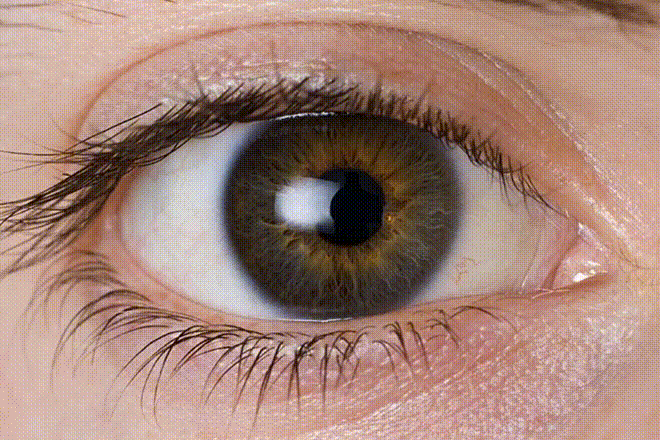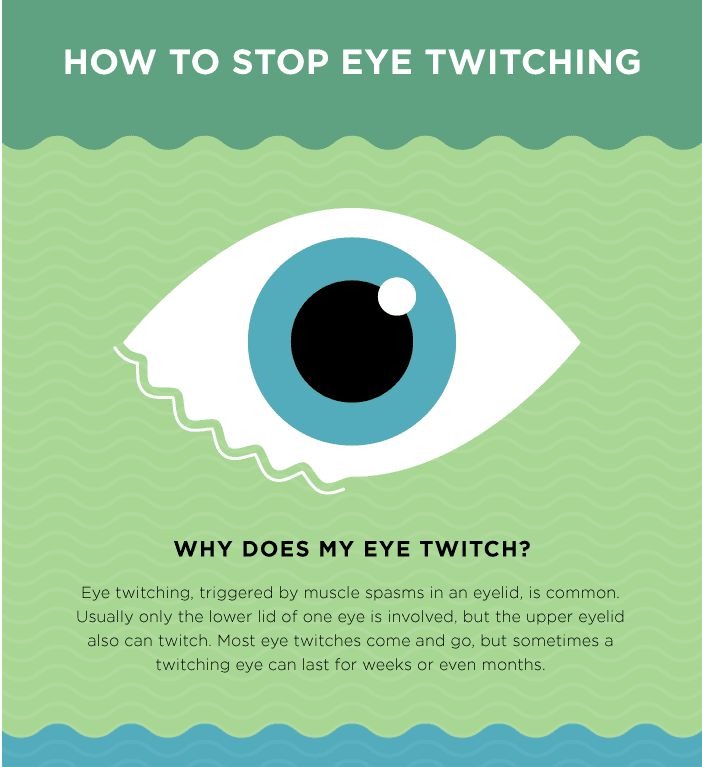Eye twitch: Causes, types and treatments

What is an eye twitch?
An eye twitch (or more accurately an eyelid twitch) is an involuntary, uncontrollable eyelid spasm. Most eye twitching lasts only a few minutes, but it’s possible to experience eyelid twitching for weeks or longer.
There are eye muscles that raise your eyelids, as well as muscles that lower them. When a problem occurs in one or more of these muscles, a twitchy eye may result.
While an eye spasm may feel noticeable, it is usually subtle and not easily seen by others.
The medical term for eye twitching is myokymia.
Types of eyelid twitches
There are three common types of eye twitching: general eyelid spasm, essential blepharospasm and hemifacial spasm. The types are organized by the severity of the twitch and whether other areas of the face are affected.
Eye twitch or tic (general eyelid spasm)
When you think of an “eye twitch,” you’re probably picturing a general eyelid spasm. This is a slight, temporary pulsing or flickering of the eyelid.
General eye spasms are usually unilateral, meaning they only affect one eye at a time. However, it’s possible for both eyes to experience a general spasm. Depending on which eye muscle is affected, you may have under eye twitching or a twitch in the upper eyelid.
Fatigue, too much caffeine or physical or emotional stress usually cause a general eye spasm. It is common, does not affect vision and will likely go away on its own.
Essential blepharospasm
Essential blepharospasm usually begins as an involuntary increase in a person’s blink rate. Winking or scrunching up the face are also common behaviors in people with the condition.
Over time, it may progress into tightly squeezing the eyes shut. This can temporarily affect a person’s ability to see. The neck and other parts of the face, such as the mouth, may also be affected. Episodes of essential blepharospasm can last anywhere from a few minutes to several hours.
While essential blepharospasm is very rare, it can be debilitating for those who have severe cases. The condition is caused by abnormal nerve impulses. What triggers the abnormal impulses is not fully understood. A common and effective treatment for significant blepharospasm is Botox injections in the affected area.
SEE RELATED: Why Do I Blink So Much?
Hemifacial spasm
This is a neuromuscular disorder that causes frequent, involuntary muscle contractions on one side of the face.
The condition usually begins with a twitching eyelid. As it progresses, the twitch gets strong enough to force the eye to close. Eventually, the spasm spreads to the lower part of the face. This may cause the mouth to pull to one side or similar behavior.
In its most severe state, a hemifacial spasm will affect all the muscles on one side of the face, and spasm will occur almost constantly. Hemifacial spasms usually result from a blood vessel pressing on the facial nerve.
SEE RELATED: Eyebrow Twitching: Causes and Treatment
Why does my eye twitch?
There are many possible reasons behind a twitchy eye. Eye twitch causes may be minor with simple solutions or be more complex and need medical attention.

Common eye twitching causes
Stress – Anxiety or stress often leads to tension in the muscles. Prolonged tension can result in muscles twitching.
Fatigue – Chemicals in the brain known as neurotransmitters send information from the brain to the nerves that control muscle movement. Fatigue caused by lack of sleep can affect how the neurotransmitters work. This can lead to muscle twitching, especially around the eyes.
Caffeine – Caffeine is a stimulant. When you consume too much of it , it can stimulate involuntary muscle movement, or twitching. Twitching may occur anywhere, including the eyelids.
Dehydration – Muscle mass is largely made of water — around 75%. This hydration in the muscles helps support their function. Being dehydrated can interrupt muscle function, leading to a twitch.
Vitamin deficiency – Vitamins such as calcium, magnesium and Vitamin D are important for proper muscle function. If you’re deficient in one or more of these, it may cause muscle weakness and/or twitching.
Medication – Certain medications, including antidepressants, anti-anxiety drugs, diuretics and steroids can cause electrolyte imbalances. These imbalances can lead to muscle spasms. Consult with your doctor about any medications you’re taking and what side effects they may cause.
Eye strain – Overexertion of the muscles can cause them to twitch. The muscles in the eye are no different. Focusing for long periods of time can strain the eye muscles, leading to a spasm of the eyelid.
Drugs – Stimulant drugs, like amphetamines, have a similar effect on the muscles as caffeine (another stimulant). This includes muscles twitching, which may affect the eyelids.
Alcohol – Alcohol consumption hinders the body’s ability to absorb nutrients. Excessive use can result in vitamin deficiencies and, in turn, cause muscle spasms throughout the body, including the eyes.
Allergies – Allergies cause the body to release a chemical called histamine. Histamine affects the smooth muscle and blood vessels, which can cause the muscles to spasm.
Other common causes of eye spasms include:
Photophobia (light sensitivity)
Eye irritation
Rare eye twitch causes
More serious eye twitching causes are usually due to a neurological problem. These causes are rarer than the ones listed above and may require medical treatment. They include:
Multiple sclerosis – Multiple sclerosis is an autoimmune disease in which the immune system attacks healthy tissue in the brain and spinal cord.
Parkinson’s disease – Parkinson’s is a brain disorder that causes uncontrolled movements, including tremors and muscle stiffness.
Brain damage – Brain damage may be caused by inflammation in certain areas of the brain, such as the thalamus, basal ganglia or brainstem. A stroke may also cause damage that leads to eye spasms.
Dystonia – Dystonia is a condition in which involuntary muscle contractions cause repetitive movements or unnatural postures.
Tourette syndrome – Tourette syndrome is a neurological disorder that causes sudden, involuntary, repetitive movements or vocal sounds.
Bell’s palsy – Bell’s palsy is a condition characterized by facial muscle weakness or paralysis. Most cases are associated with viral infection.
Meige syndrome – Meige syndrome is a neurological movement disorder characterized by forceful muscle contractions. Affected muscle groups are those of the jaw, tongue and eyes.
SEE RELATED: Sixth Nerve Palsy
How can I stop eye twitching?
To stop your eyelid twitching, figure out what the possible causes might be.
Eye twitching treatment may be as simple as making changes to your lifestyle, like eating a balanced diet, getting regular exercise and drinking plenty of water. This can significantly reduce your risk of eye twitching or help make an eyelid twitch disappear.
Trying to reduce stress and getting enough sleep can make a difference in your eye health. Adding more fruits and vegetables to your diet can help with vitamin deficiency. You can also achieve this by taking a daily multivitamin.
Practicing moderation when it comes to screen time and caffeine and alcohol consumption can also help with eye jumping. For the sake of your eyes and your overall health, stop smoking and recreational drug use. Doing so will help improve many areas of your mental and physical condition.
If you believe allergies, certain medications you’re taking or an underlying condition like dry eyes is the cause of your eye twitching, talk to your doctor. They can tell you the best way to treat a twitchy eye.
Potential complications
A twitching eye that is severe and persistent can cause permanent damage to the eyelids, as well as to surrounding areas. Complications that could arise from this include:
Upper eyelids becoming droopy (ptosis)
Eyebrows drooping lower than normal
Excess skin forming around the eyes
Eyelids showing abnormal folding
While these complications seem cosmetic, severe cases can affect vision. For example, advanced ptosis can cause the eyelid to droop into a person’s visual field and obstruct eyesight. These complications can often be improved or resolved with surgical treatment.
READ MORE: Ptosis Surgery for Droopy Eyelids
When to see an eye doctor
See an eye doctor immediately if you experience constant eye twitching. Sudden changes in appearance or movement of half your face, including your eyelids, are also reasons to see a doctor.
Finally, if both eyelids clamp down so tight it's impossible to open your eyes, seek medical attention. These can be signs of a serious condition and should be evaluated immediately by an eye doctor.
Eye twitching. Cedar-Sinai. Accessed October 2022.
What's causing that pesky eye twitch? Cleveland Clinic. November 2021.
Eye twitching. Johns Hopkins Medicine. Accessed October 2022.
Eyelid spasms (eye twitching or eye twitch). Kellogg Eye Center. Accessed October 2022.
What is an eyelid spasm or twitching eyelid? American Academy of Ophthalmology. April 2022.
Hemifacial spasm. National Institute of Neurological Disorders and Stroke. July 2022.
Muscle twitch: Causes, symptoms, treatment, and prevention. Medical News Today. March 2019.
What causes muscle twitches? U.S. News Health. July 2019.
Alcoholic myopathy: Symptoms, risks & treatment. American Addiction Centers. October 2022.
Antihistamine side effects: When to stop taking allergy medicine. News Medical. November 2019.
Parkinson’s disease: Causes, symptoms, and treatments. National Institute on Aging. April 2022.
Dystonias fact sheet. National Institute of Neurological Disorders and Stroke. July 2022.
Tourette syndrome fact sheet. National Institute of Neurological Disorders and Stroke. July 2022.
Meige syndrome. National Organization of Rare Disorders. Accessed October 2022.
Page published on Tuesday, 21 April 2020
Page updated on Tuesday, 22 August 2023
Medically reviewed on Sunday, 30 October 2022







